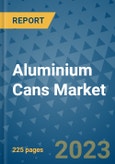Aluminium Cans Market Set to Surge, Predicted to Reach $78.11 Billion by 2030
The global aluminium cans market has witnessed significant growth in recent years and is expected to continue its upward trajectory. In 2022, the market size reached $49 billion, and it is projected to rise substantially to $78.11 billion by 2030, marking a healthy CAGR of 6% between 2023 and 2030, according to the latest report by [Your Company Name/Research Firm Name].Key Market Trends and Drivers:
1. Sustainability and Recycling: The increasing focus on sustainability and recycling practices is a key driver of growth in the aluminium cans market. Aluminium cans are highly recyclable and align with global efforts to reduce single-use plastics.2. Beverage Industry Development: The beverage industry, encompassing soft drinks, energy drinks, alcoholic beverages, and non-alcoholic options like water and juices, is a major driver of aluminium can demand. As consumer preferences evolve, the demand for convenient and portable beverage packaging remains strong.
3. Population Growth and Convenience: As the global population continues to grow, and consumer preferences evolve, the demand for convenient and portable beverage packaging, such as aluminium cans, remains robust.
A Look Back and a Look Forward - Comparative Analysis:
The aluminium cans market has a rich history of growth and adaptation. Historically, aluminium cans revolutionized the packaging industry with their lightweight, durable, and recyclable properties. They became the preferred choice for various beverages, from soft drinks to beer and more. Recycling initiatives and sustainability efforts further increased their adoption.In the present, the market remains strong, with sustainability concerns and the global movement against single-use plastics boosting demand. Convenience and health and safety considerations during the COVID-19 pandemic have further driven demand. Innovations in can design and materials have showcased the industry's adaptability.
Looking ahead, the aluminium cans market is poised for continued growth, with sustainability at the forefront. Diversification in beverages, including craft and health-focused options, is expected to expand the market. Digital printing and customisation trends will create new opportunities, and regulatory changes may incentivize even greater adoption of aluminium cans. Expansion into emerging markets and supply chain enhancements are also on the horizon.
Key Growth Determinants:
Recyclability and Low Energy Use: The recyclability and lower energy consumption of aluminium cans compared to other packaging materials have been key drivers of their adoption. Each recycling cycle conserves energy, reduces carbon emissions, and minimizes the need for raw material extraction and processing.Superior Heat Conductivity, Hygiene, and Safety: Aluminium cans offer exceptional heat conductivity, preserving food freshness and prolonging shelf-life. Their natural barrier properties protect contents from contaminants, ensuring hygiene and safety. The lightweight yet robust nature of aluminium cans makes them practical for handling, transportation, and storage.
Major Growth Barriers:
Technological Advancements and Brand Loyalty: Technological advancements in rival packaging materials and strong brand loyalty pose challenges for the aluminium cans market. Competing materials, such as plastics and glass, continue to evolve, and consumers often have deep attachments to specific brands and packaging.Competition from Alternative Packaging Materials: Competition from other packaging materials, including biodegradable plastics and lightweight glass options, challenges aluminium's dominance. Regulatory changes and evolving consumer preferences can drive the use of alternative materials.
Key Trends and Opportunities:
Sustainability and Circular Economy: Aluminium cans' recyclability and lower carbon footprint position them as a sustainable choice. They contribute to the circular economy by continuously reusing materials, minimizing waste. Leveraging these environmental benefits can drive further market growth.Craft Beverage Partnerships: Collaboration with craft beverage producers presents an opportunity for the aluminium cans market. Craft producers increasingly prefer aluminium cans for their products, and customised packaging can help these brands stand out.
Regional Outlook:
North America: The region has a strong beverage industry and a focus on sustainability, making it an attractive market for aluminium cans. Regulatory support for recycling initiatives further boosts adoption.Asia Pacific: Anticipated to have the highest CAGR, Asia Pacific benefits from population growth, urbanization, and sustainability concerns, driving increased consumption of beverages and aluminium cans.
Leaders in the Global Aluminium Cans Market Space
- Nussbaum Matzingen AG
- Canpack S.A.
- Pohli Verpackungen
- Novelis Inc
- Ball Corporation
- Crown Holdings Inc
- Ardagh Group S.A.
- Baosteel Metal Co. Ltd.
- Showa Aluminium Can Corporation
- Envases Universales
- Kian Joo Group
- CMPC Holdings Limited
- Norsk Hydro ASA
This product will be delivered within 1-3 business days.
Table of Contents
1. Executive Summary
2. Market Overview
3. Global Aluminium Cans Market Outlook, 2018 - 2030
4. North America Aluminium Cans Market Outlook, 2018 - 2030
5. Europe Aluminium Cans Market Outlook, 2018 - 2030
6. Asia Pacific Aluminium Cans Market Outlook, 2018 - 2030
7. Latin America Aluminium Cans Market Outlook, 2018 - 2030
8. Middle East & Africa Aluminium Cans Market Outlook, 2018 - 2030
9. Competitive Landscape
10. Appendix
Companies Mentioned
- Nussbaum Matzingen AG
- Canpack S.A.
- Pohli Verpackungen
- Novelis Inc
- Ball Corporation
- Crown Holdings Inc
- Ardagh Group S.A.
- Baosteel Metal Co. Ltd.
- Showa Aluminium Can Corporation
- Envases Universales
- Kian Joo Group
- CMPC Holdings Limited
- Norsk Hydro ASA
Methodology

LOADING...








